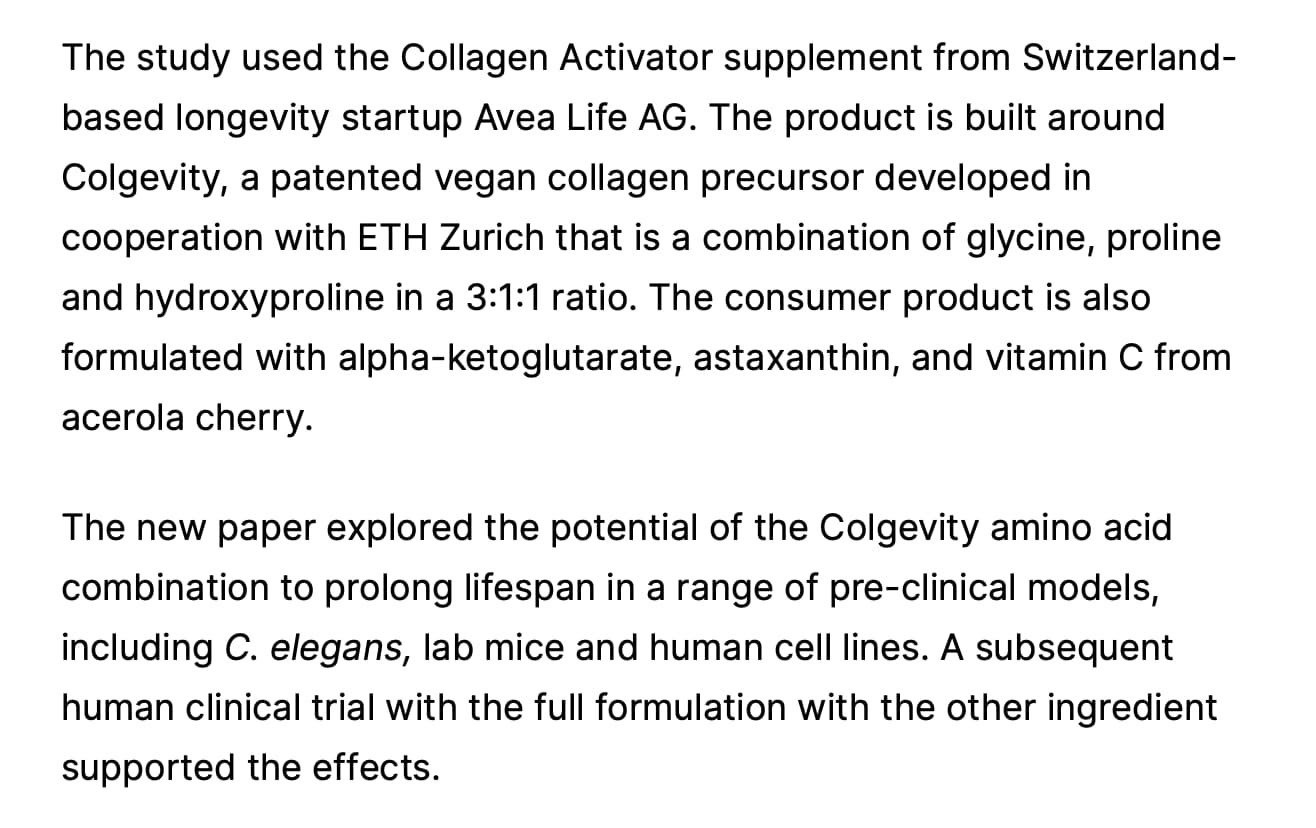Researchers report that a targeted mixture of three amino acids — glycine, proline, hydroxyproline — in a 3:1:1 ratio, the minimal “building block” of collagen, may drive conserved longevity and rejuvenation signals across species, from nematodes to humans.
In the new study published in npj Aging (November 2025) , investigators combined this amino-acid triplet with known collagen-supportive cofactors — namely α-ketoglutarate (AKG), vitamin C, and in some formulations the antioxidant astaxanthin — and tested effects stepwise: first in worms, then human skin cells, old mice, and finally a small human observational cohort.
Key preclinical findings
- In C. elegans, the 3:1:1 glycine:proline:hydroxyproline (Gly:Pro:Hyp) mix extended mean lifespan by **6–27%**across five independent trials, outperforming bulk collagen extract. Worms retained collagen-reporter expression and better “healthspan” (swimming/thrashing) late in life.
- When AKG — a known geroscience metabolite that modulates epigenetics and metabolism — was added, lifespan extension further increased. This suggests the two act via partly independent but synergistic longevity-promoting pathways.
- In human dermal fibroblasts, Gly:Pro:Hyp triggered robust up-regulation of extracellular-matrix (ECM) and collagen-related genes within hours, indicating stimulated ECM synthesis and remodeling.
- In a small cohort of 20-month old mice (analogous to elderly humans), the amino-acid supplementation improved grip strength and reduced age-related fat accumulation — two functional proxies of healthy aging — while appearing safe (no overt organ toxicity).
Altogether, these preclinical data suggest that collagen homeostasis — long recognized as central to tissue integrity — may be a tractable longevity axis, and that simple amino-acid supplementation might nevertheless exert systemic, cross-tissue benefits.
Human observational data: preliminary but provocative
The study’s human arm administered a commercially marketed formulation (“Collagen Activator” / Colgevity™) daily for 6 months to 66 generally healthy adults (mean age ~47). The product combined the 3:1:1 amino-acid mix with vitamin C, AKG, and astaxanthin. Skin hydration, elasticity, and dermatological appearance improved significantly within 1–3 months.
More strikingly — at least for anti-aging enthusiasts — participants exhibited a mean reduction of 1.4 years in “biological age” (as measured by a commercial saliva DNA methylation clock) over six months (p = 0.04).
The authors interpret this as proof-of-concept that collagen-substrate supplementation can exert “rejuvenating” effects at molecular (epigenetic), cellular (skin ECM), and functional (strength, fat mass) levels — consistent with the cross-species data.
Why this matters for longevity and healthy-aging strategies
- ECM/collagen maintenance as a pillar of healthy aging: Collagen and ECM stability are essential to tissue integrity, elasticity, and repair. Age-related loss or dysfunction of ECM underlies skin sagging, bone fractures, tendon weakness, vascular stiffening, and overall frailty. By demonstrating that simple amino-acid building blocks trigger ECM synthesis and systemic benefits, this work elevates ECM support from cosmetic or structural maintenance to a bona fide geroscience intervention axis.
- A potentially low-risk, accessible “longevity tool”: Because glycine, proline, and hydroxyproline are food-derived amino acids — part of the normal collagen breakdown/absorption pool — and because AKG and vitamin C are already studied as safe nutritional/metabolic factors, this strategy may be more scalable and lower risk than many novel geroprotective drugs.
- Synergy matters: The combination with AKG (a metabolic and epigenetic regulator), plus vitamin C (collagen hydroxylation cofactor) and antioxidants (astaxanthin), suggests a multi-layered support strategy: substrate supply, enzymatic co-factors, and oxidative-stress mitigation. This aligns with the emerging view that healthy aging likely requires multi-modal interventions rather than single “silver-bullet” compounds.
- Rejuvenation rather than just disease prevention: The observed epigenetic age reversal, improved skin metrics, and functional gains in muscle/fat suggest that such an intervention could contribute not just to delaying pathology, but to restoring aspects of youthful physiology — a core goal for longevity-minded individuals.
Important caveats & what remains to be demonstrated
- The human trial was uncontrolled and observational, so the biological-age drop could reflect placebo effect, lifestyle drift, measurement variability, or regression-to-the-mean.
- The formulation combined several active components — you cannot attribute the effect solely to Gly:Pro:Hyp.
- The epigenetic clock used is commercial and its predictive value for long-term healthspan or lifespan remains debated.
- The mouse data — while promising — did not include survival/lifespan curves.
Bottom line (for longevity-oriented individuals)
This study marks a compelling advance in geroscience: a minimalist, diet-derived amino-acid ratio — supplemented with metabolic cofactors — appears to exert conserved, cross-species benefits for ECM maintenance, tissue function, and markers of biological age. If validated in rigorous placebo-controlled human trials, this “collagen-building block + co-factors” paradigm could become a foundational pillar in healthy-aging regimens — a low-friction, broadly accessible intervention aimed not just at disease prevention but at restoring youthful tissue quality and function. Until then, it should be viewed as a well-reasoned, promising hypothesis rather than a proven “rejuvenation therapy.”
Full, Open Access Paper:
Related News Coverage:
